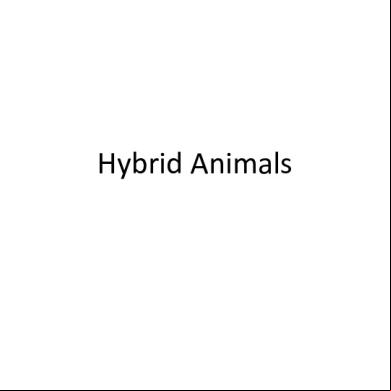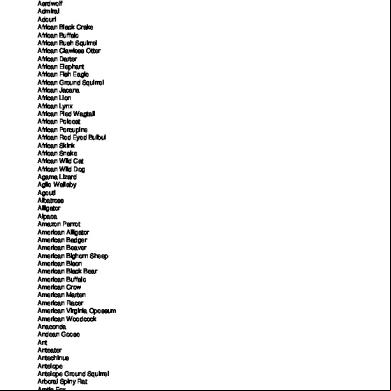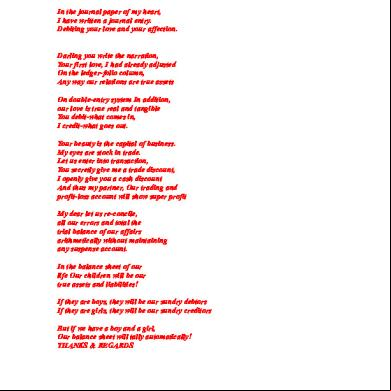Hybrid Animals 2e1as
This document was ed by and they confirmed that they have the permission to share it. If you are author or own the copyright of this book, please report to us by using this report form. Report 3b7i
Overview 3e4r5l
& View Hybrid Animals as PDF for free.
More details w3441
- Words: 1,086
- Pages: 13
Hybrid Animals
Cama • • • • • • • • • • • •
Cama is hybrid animal created by crossbreeding dromedary (one-humped) camel from Asia with South American llama. First cama was born in the United Emirates in 1998. Cama can reach 49 to 57 inches in height (at the shoulder) and 180 to 1.000 pounds of weight. Cama is covered with soft fur that is slightly shorter than the fleece of llama. Cama has short ears, long tail and cloven hooves. It doesn't have hump on the back. Cama is a herbivore. Its diet is based on various types of shrubs. Just like camel, cama can drink large quantities of water at once and survive long periods of time without it. Cama was created by crossbreeding male camel with female llama. Mixing of male llama and female camel proved to be unsuccessful. Cama was created via artificial insemination due to great differences in the size of camel and llama (camel is 6 times heavier than llama). Cama vocalizes like camel. Goal of mixing of camel and llama was to create large and strong animal with cooperative temper that can be used as a pack animal in harsh desert climate. Llama and camel have the same number of chromosomes (74). Experts estimate that an average lifespan of cama is probably 30 to 40 years.
Beefalo •
• • • • • • • •
• •
Beefalo, also known as "cattalo", is a hybrid created by mixing American bison (also known as American buffalo) with different types of domestic cattle. Beefalo can reach 55 inches in height and 1.500 to 2.000 pounds of weight. Beefalo is covered with fine, usually dark-colored robe that is evenly distributed on the body. Beefalo has bovine-like body without hump. It is docile by nature. Beefalo has higher tolerance to diseases and ability to survive in the areas with cold climate that are not suitable for domestic cattle. Beefalo is usually created by crossbreeding female bison with domestic bull. Crossbreeding of male bison and female cow produces less offspring. Beefalo contains 37.5% genes of bison and 63.5% genes of domestic cattle. Beefalo can be produced naturally or artificially (via insemination or insertion of fertilized embryo). Beefalo is weaned at the age of 205 days. It starts to eat grass early in life and requires less food than domestic cattle. Beefalo can successfully grow and develop without grain supplements. It efficiently converts consumed grass into high-quality meat rich in proteins. Beefalo is very small at birth, with an average weight of 40 to 60 pounds. Beefalo is also valuable source of milk that is rich in butterfat and has sweeter, creamier taste compared with the milk of domestic cow.
Coywolf • • • • • • • • • •
•
Coywolf is type of canid that was created by mixing western coyotes and eastern wolves. Coywolf can reach 4 to 5 feet in length and 35 to 45 pounds of weight. Coywolf has thick coat that can be blondish or dark-blackish in color. Coywolf has big skull, wide, powerful jaws, short, round ears, long legs and strong, wolf-like body (coywolf is larger than coyote, but smaller than wolf). Coywolf is a carnivore. Its diet is based on the voles, mice, rabbits, woodchucks, white-tail deer, geese, ducklings and carrion. It occasionally consumes berries and nuts. Coywolf is an apex predator. Unlike coyote, which is solitary hunter, coywolf hunts in organized groups - packs, like wolf. Coywolf is social animal that lives in groups of 3 to 5 animals. Coywolf produces loud (wolf-like) howls which gradually change into yipping sound (typical for coyote) for communication with other coywolves. Coywolf reaches sexual maturity at the age of 2 years. Recent DNA analysis suggests that genome of coywolf also contains traces of grey wolf and domestic dog. All in all, coywolf is roughly 1/4 wolf, 2/3 coyote, while the remaining genes belong to wild dog. Coywolf has an average lifespan of 3 to 5 years in the wild and around 10 years in the urban areas.
Dzo • •
• • • • • • • •
Dzo is large bovid created via cross-breeding of yak with domestic cattle in Tibet. It is strong, productive (in of meat and milk) animal that doesn't increase farming expenses. Dzo can reach 5.5 feet in height and up to 1.300 pounds of weight. Males are larger than females. Dzo is covered with long, shaggy coat (that is typical for yak) in the shades of white, brown and black. Dzo has cattle-like face with large horns. It has hump on the back and large, sturdy body. In some areas, dzo is also known as yakow, because it was created by mixing the yak with cow. Dzo is herbivore that doesn't require any additional supplements aside from grass, lichen and other plants that are normally consumed. Dzo is often larger than both of its parents and able to survive on the altitude of more than 10.000 feet. Dzo is also used as working animal on the farms. Dzo is often kept on the farms as a source of meat and milk. It produces more milk compared with yak. Milk is used both for drinking and for the manufacture of cheese and butter.
Grolar bear • • • • • • • • • • •
Grolar bear is a hybrid species of bear, created by interbreeding of grizzly bear and polar bear. First grolar bear has been observed in the wild in 2006. Grolar bear can reach 40 to 60 inches in height, 78 to 120 inches in length and 400 to 1.500 pounds of weight. Grolar bear is slightly smaller than a polar bear, but much better adapted to the warmer climate compared with it. Grolar bear has thick, creamy-white fur with brown patches around eyes, on the legs and paws. Grolar bear has wide face, long neck, hump on the shoulders, strong body and large claws on the feet. Its soles are partially hairy. Grolar bear has the same hunting technique like polar bear. It breaks the ice with its feet to find its favorite food - seals. Captive grolar bear hurls toys to the side, the same way polar bear hurls its prey. Grolar bear is weaker swimmer compared with polar bears. It is clumsy on the ice due to long claws. Grolar bear rests on its stomach with widely spread hind legs (like polar bear). Grolar bear is also known as "nanulak".
Liger
Cama • • • • • • • • • • • •
Cama is hybrid animal created by crossbreeding dromedary (one-humped) camel from Asia with South American llama. First cama was born in the United Emirates in 1998. Cama can reach 49 to 57 inches in height (at the shoulder) and 180 to 1.000 pounds of weight. Cama is covered with soft fur that is slightly shorter than the fleece of llama. Cama has short ears, long tail and cloven hooves. It doesn't have hump on the back. Cama is a herbivore. Its diet is based on various types of shrubs. Just like camel, cama can drink large quantities of water at once and survive long periods of time without it. Cama was created by crossbreeding male camel with female llama. Mixing of male llama and female camel proved to be unsuccessful. Cama was created via artificial insemination due to great differences in the size of camel and llama (camel is 6 times heavier than llama). Cama vocalizes like camel. Goal of mixing of camel and llama was to create large and strong animal with cooperative temper that can be used as a pack animal in harsh desert climate. Llama and camel have the same number of chromosomes (74). Experts estimate that an average lifespan of cama is probably 30 to 40 years.
Beefalo •
• • • • • • • •
• •
Beefalo, also known as "cattalo", is a hybrid created by mixing American bison (also known as American buffalo) with different types of domestic cattle. Beefalo can reach 55 inches in height and 1.500 to 2.000 pounds of weight. Beefalo is covered with fine, usually dark-colored robe that is evenly distributed on the body. Beefalo has bovine-like body without hump. It is docile by nature. Beefalo has higher tolerance to diseases and ability to survive in the areas with cold climate that are not suitable for domestic cattle. Beefalo is usually created by crossbreeding female bison with domestic bull. Crossbreeding of male bison and female cow produces less offspring. Beefalo contains 37.5% genes of bison and 63.5% genes of domestic cattle. Beefalo can be produced naturally or artificially (via insemination or insertion of fertilized embryo). Beefalo is weaned at the age of 205 days. It starts to eat grass early in life and requires less food than domestic cattle. Beefalo can successfully grow and develop without grain supplements. It efficiently converts consumed grass into high-quality meat rich in proteins. Beefalo is very small at birth, with an average weight of 40 to 60 pounds. Beefalo is also valuable source of milk that is rich in butterfat and has sweeter, creamier taste compared with the milk of domestic cow.
Coywolf • • • • • • • • • •
•
Coywolf is type of canid that was created by mixing western coyotes and eastern wolves. Coywolf can reach 4 to 5 feet in length and 35 to 45 pounds of weight. Coywolf has thick coat that can be blondish or dark-blackish in color. Coywolf has big skull, wide, powerful jaws, short, round ears, long legs and strong, wolf-like body (coywolf is larger than coyote, but smaller than wolf). Coywolf is a carnivore. Its diet is based on the voles, mice, rabbits, woodchucks, white-tail deer, geese, ducklings and carrion. It occasionally consumes berries and nuts. Coywolf is an apex predator. Unlike coyote, which is solitary hunter, coywolf hunts in organized groups - packs, like wolf. Coywolf is social animal that lives in groups of 3 to 5 animals. Coywolf produces loud (wolf-like) howls which gradually change into yipping sound (typical for coyote) for communication with other coywolves. Coywolf reaches sexual maturity at the age of 2 years. Recent DNA analysis suggests that genome of coywolf also contains traces of grey wolf and domestic dog. All in all, coywolf is roughly 1/4 wolf, 2/3 coyote, while the remaining genes belong to wild dog. Coywolf has an average lifespan of 3 to 5 years in the wild and around 10 years in the urban areas.
Dzo • •
• • • • • • • •
Dzo is large bovid created via cross-breeding of yak with domestic cattle in Tibet. It is strong, productive (in of meat and milk) animal that doesn't increase farming expenses. Dzo can reach 5.5 feet in height and up to 1.300 pounds of weight. Males are larger than females. Dzo is covered with long, shaggy coat (that is typical for yak) in the shades of white, brown and black. Dzo has cattle-like face with large horns. It has hump on the back and large, sturdy body. In some areas, dzo is also known as yakow, because it was created by mixing the yak with cow. Dzo is herbivore that doesn't require any additional supplements aside from grass, lichen and other plants that are normally consumed. Dzo is often larger than both of its parents and able to survive on the altitude of more than 10.000 feet. Dzo is also used as working animal on the farms. Dzo is often kept on the farms as a source of meat and milk. It produces more milk compared with yak. Milk is used both for drinking and for the manufacture of cheese and butter.
Grolar bear • • • • • • • • • • •
Grolar bear is a hybrid species of bear, created by interbreeding of grizzly bear and polar bear. First grolar bear has been observed in the wild in 2006. Grolar bear can reach 40 to 60 inches in height, 78 to 120 inches in length and 400 to 1.500 pounds of weight. Grolar bear is slightly smaller than a polar bear, but much better adapted to the warmer climate compared with it. Grolar bear has thick, creamy-white fur with brown patches around eyes, on the legs and paws. Grolar bear has wide face, long neck, hump on the shoulders, strong body and large claws on the feet. Its soles are partially hairy. Grolar bear has the same hunting technique like polar bear. It breaks the ice with its feet to find its favorite food - seals. Captive grolar bear hurls toys to the side, the same way polar bear hurls its prey. Grolar bear is weaker swimmer compared with polar bears. It is clumsy on the ice due to long claws. Grolar bear rests on its stomach with widely spread hind legs (like polar bear). Grolar bear is also known as "nanulak".
Liger










